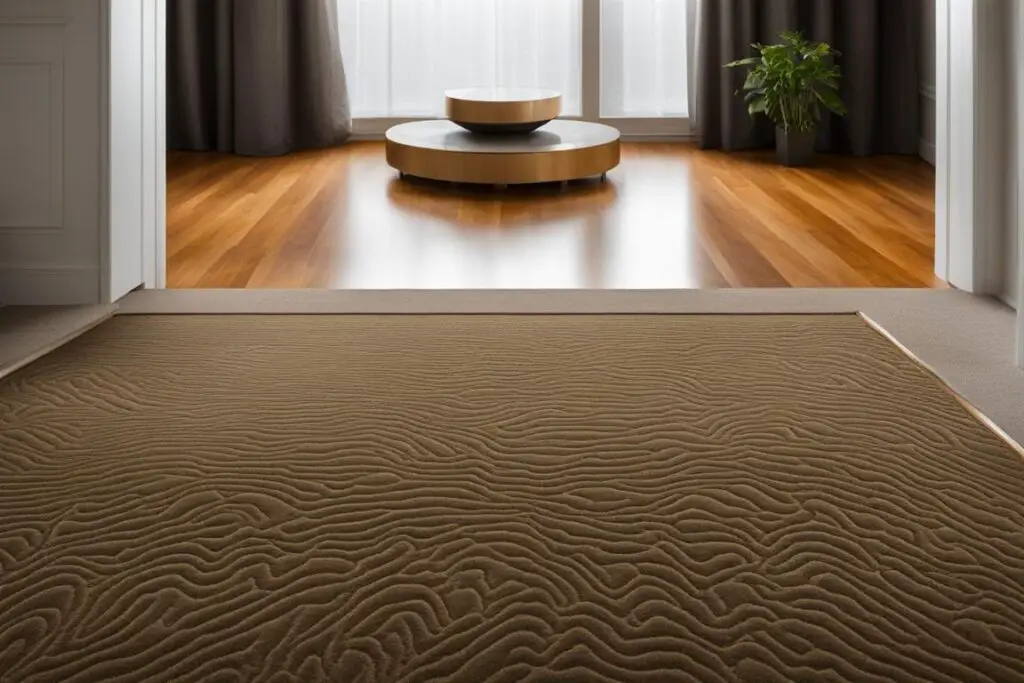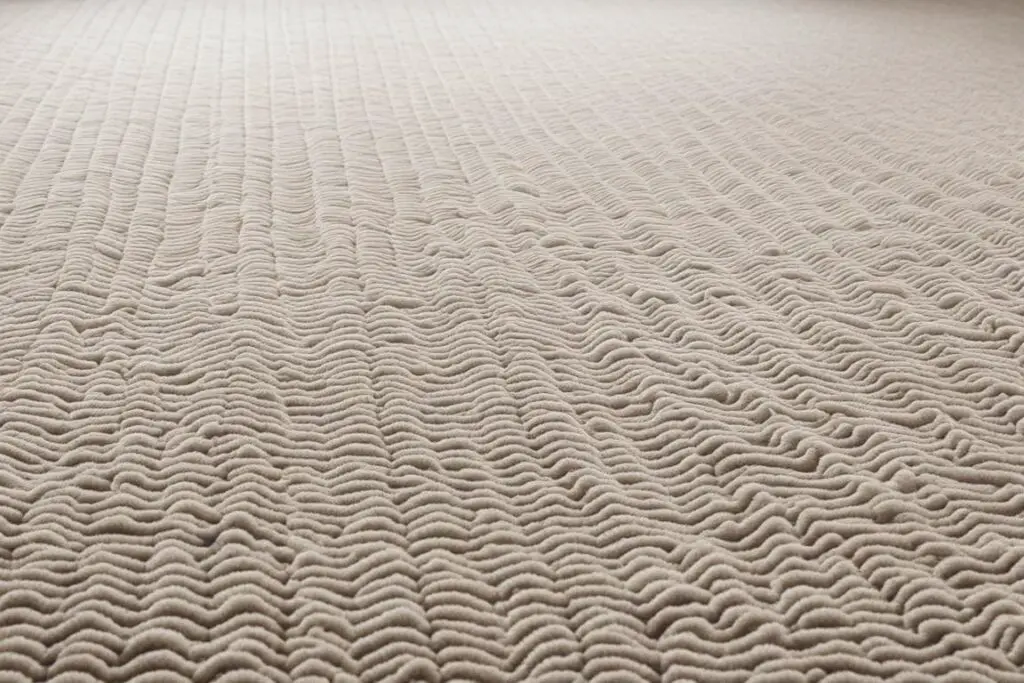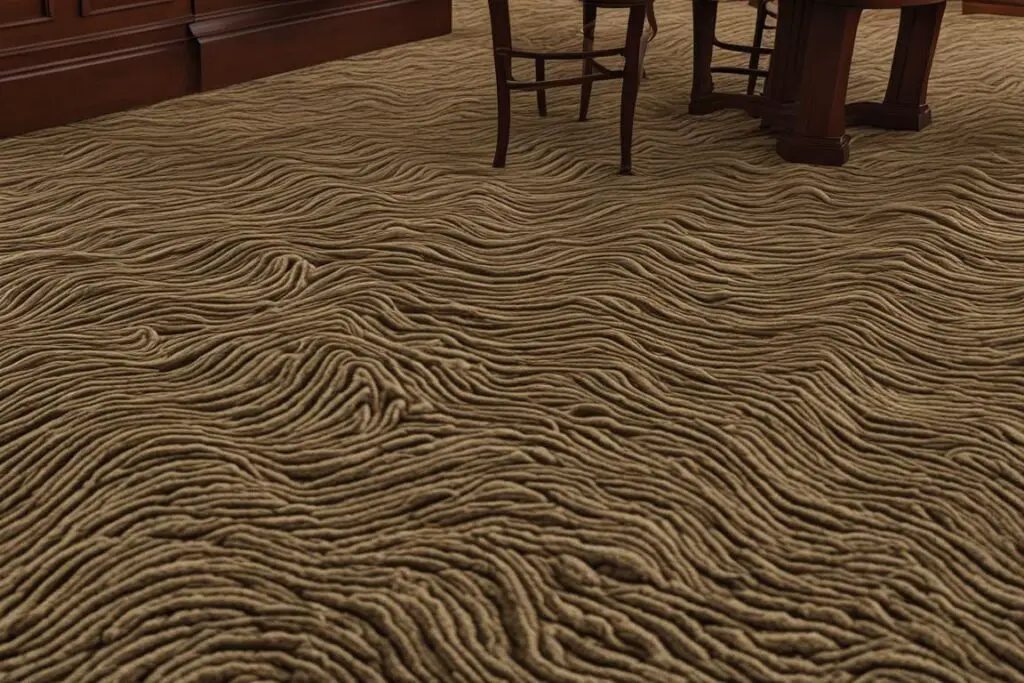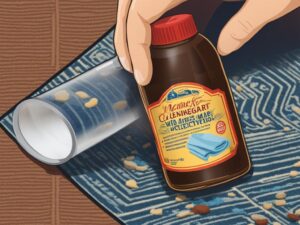Carpet ripples, also known as buckling or stretching, can be a frustrating problem for homeowners. Not only do they detract from the appearance of your carpet, but they can also pose a tripping hazard. Understanding the causes of carpet rippling can help you address the issue promptly and prevent further damage.
There are several factors that can contribute to carpet rippling. These include:
- Improper installation
- Inadequate padding
- Adhesive failure
- Loss of elasticity in older carpets
- Tension failure due to heavy foot traffic or dragging heavy items
If you’ve noticed ripples in your carpet, it’s essential to take action and address the issue promptly. Let’s explore the common causes of carpet rippling and the steps you can take to resolve this problem.
Key Takeaways:
- Carpet ripples, also known as buckling or stretching, can be caused by various factors.
- Common causes of carpet rippling include improper installation, inadequate padding, adhesive failure, loss of elasticity in older carpets, and tension failure due to heavy foot traffic or dragging heavy items.
- If you notice ripples in your carpet, it’s important to address the issue promptly to prevent further damage.
Professional Cleaning and Carpet Ripples
Contrary to popular belief, professional cleaning does not cause carpet ripples. Any ripples that appear after professional cleaning are temporary and will settle flat once the carpet is completely dry. If ripples persist, there is likely another underlying issue causing the problem.

Myth Debunked: Professional Cleaning and Carpet Ripples
There is a common misconception that professional cleaning is the cause of carpet ripples. However, this is not true. In fact, professional cleaning can actually help alleviate existing ripples and restore the carpet’s appearance.
“Professional cleaning does not cause carpet ripples. It is a misconception that needs to be debunked. Ripples that appear after professional cleaning are temporary and will settle flat once the carpet is completely dry.”
When carpets are professionally cleaned, specialized equipment and techniques are used to remove dirt, stains, and odors. The cleaning process involves deep cleaning the fibers and extracting any residual moisture. While this thorough cleaning may cause temporary ripples, they are simply a result of the moisture and pressure applied during the cleaning process.
Once the carpet is completely dry, usually within 24 to 48 hours, these temporary ripples will flatten out on their own. It is important to allow the carpet adequate time to dry completely before evaluating the appearance of the carpet.
If ripples persist after the carpet has dried, it is unlikely that the professional cleaning caused the issue. Instead, there may be another underlying problem, such as improper installation or an issue with the carpet padding.
Professional cleaners are trained to identify and address such issues and can provide recommendations for resolving carpet ripples. They may suggest contacting the carpet retailer or installer for further assistance in rectifying the problem.
The Benefits of Professional Cleaning
While professional cleaning does not cause carpet ripples, it offers several benefits that contribute to the overall health and longevity of your carpet:
- Removal of deep-seated dirt, allergens, and bacteria
- Restoration of the carpet’s original color and texture
- Elimination of stubborn stains and odors
- Improvement in indoor air quality
Regular professional cleaning, in conjunction with proper maintenance and care, can help prevent issues such as carpet rippling and prolong the lifespan of your carpet.
Improper Installation and Carpet Buckling
One of the common causes of carpet rippling is improper installation. When the carpet is not stretched adequately during installation or if incorrect underlayer cushioning is used, buckling may occur. To prevent this issue, it is crucial to ensure proper installation of the carpet.
During the installation process, it is important to hire a professional who has experience and expertise in carpet installation. They will know the correct techniques to stretch the carpet evenly and ensure it is taut. Additionally, using the right underlayer cushioning, such as a high-density foam padding, can also help prevent carpet buckling.
Benefits of Proper Installation
Proper installation not only prevents carpet ripples but also offers other benefits:
- Improved appearance: A properly installed carpet will have a smooth and flat surface, enhancing the overall aesthetics of your space.
- Extended lifespan: When the carpet is stretched correctly, it reduces the amount of wear and tear on the fibers, increasing the longevity of the carpet.
- Enhanced comfort: A well-installed carpet provides a comfortable and cushioned feel underfoot, adding to the overall comfort of your home.
By prioritizing proper installation, you can avoid the frustration and inconvenience of dealing with carpet rippling in the future.
Note: Improper installation is a common cause of carpet rippling. Ensure the carpet is stretched adequately and the correct underlayer cushioning is used to prevent buckling.
Moisture as a Cause of Carpet Rippling
One of the key factors causing carpet to ripple is moisture, especially prolonged exposure to moisture and high humidity levels. Moisture can lead to swelling of the carpet fibers, resulting in unsightly ripples.
When carpets absorb moisture, their fibers expand, causing the carpet to become loose and form ripples. This can happen due to various reasons, such as excessive humidity levels in the environment or liquid spills that are not promptly addressed.
It is crucial to control the humidity levels in your home to minimize the risk of carpet rippling. Using dehumidifiers, properly sealing windows and doors, and ensuring adequate ventilation can all contribute to maintaining the ideal moisture levels.
If you live in an area with high humidity, it is important to take extra precautions to prevent moisture-related carpet issues. Promptly addressing any spills or leaks, using moisture barriers, and maintaining a well-ventilated space can help prevent moisture absorption and subsequent carpet rippling.
“Excessive moisture can wreak havoc on your carpet, leading to ripple formation. By taking appropriate measures to control humidity levels, you can protect your carpet investment and ensure a long-lasting and visually appealing flooring option for your home.”

Heavy Furniture and Carpet Buckling
One of the common triggers for carpet rippling is dragging heavy furniture across it. The weight and friction caused by this action can lead to the carpet buckling and ripples forming. To prevent this damage, it is advisable to use sliders or other protective measures when moving heavy furnishings.
“Using sliders can make a significant difference in preventing carpet rippling. They reduce the amount of friction between the furniture and the carpet, minimizing the risk of buckling and ripples.”
By using sliders or other protective measures, such as lifting heavy furniture instead of dragging, you can prevent the carpet from stretching or becoming misaligned. This simple precautionary step can help maintain the integrity and appearance of your carpet for a longer duration.
Protecting Your Carpet from Heavy Furniture
Here are some ways to protect your carpet from the effects of heavy furniture:
- Use furniture sliders: These small disks or pads can be placed under the legs or corners of the furniture, allowing it to glide smoothly without causing damage to the carpet.
- Lift the furniture: Instead of dragging heavy furniture, enlist the help of others to lift and carry it when moving from one spot to another on your carpeted floor.
- Use area rugs: To further protect high-traffic areas prone to heavy furniture, consider using area rugs or carpet protectors. These can provide an additional layer of cushioning and minimize the impact on the carpet beneath.
By employing these preventive measures, you can avoid unnecessary carpet rippling and prolong the life of your carpet.
| Preventive Measures | Effectiveness |
|---|---|
| Using furniture sliders | Highly effective in minimizing carpet rippling |
| Lifting heavy furniture | Effective, but requires extra manpower for larger items |
| Using area rugs or carpet protectors | Effective in protecting specific areas prone to heavy furniture |

Repairing Carpet Ripples
If you notice ripples in your carpet, it is important to address the issue promptly. Contact your carpet retailer or installer, especially if your carpet is new and covered under warranty. A professional carpet installation contractor can power stretch and secure the carpet, eliminating the ripples. Avoiding foot traffic in the rippled area temporarily can reduce the risk of accidents and further damage.
When addressing carpet ripples, it’s crucial to seek professional assistance to ensure the problem is properly resolved. Power stretching is a technique used by experienced carpet installation contractors to remove ripples and restore the carpet to its original state. This process involves using a specialized stretching tool to apply just the right amount of tension to the carpet, eliminating the ripples and ensuring a smooth and flat surface.
During the power stretching process, the carpet is pulled tightly, allowing the excess material causing the ripples to be stretched out and smoothed. This technique requires skill and expertise to ensure that the carpet is stretched evenly across the entire surface, eliminating any unevenness or bumps. Professional carpet installers have the knowledge and equipment necessary to perform this task efficiently and effectively, restoring your carpet’s appearance and functionality.
It is important to note that attempting DIY carpet stretching without the proper knowledge and tools can lead to further damage or ineffective results. Hiring a professional ensures that the job is done correctly, minimizing the risk of potential complications.
In addition to power stretching, carpet repair professionals may also use other techniques and tools to address specific issues contributing to carpet rippling. They can assess the underlying causes, such as inadequate padding or adhesive failure, and implement appropriate solutions. By addressing these issues comprehensively, the likelihood of future carpet rippling is significantly reduced.
Temporary Prevention Measures
While waiting for a professional to address the carpet ripples, there are temporary measures you can take to prevent further damage. One such measure is avoiding foot traffic in the rippled area. By minimizing the weight and pressure on the affected portion of the carpet, you reduce the risk of accidents and exacerbating the rippling.
It is also advisable to avoid dragging heavy items across the rippled carpet, as this can worsen the problem. If you need to move furniture or other heavy objects, consider using furniture sliders or other protective measures to prevent undue strain on the carpet.
Remember, addressing carpet ripples promptly is essential to prevent further damage and maintain the longevity of your carpet. By seeking professional assistance and taking temporary prevention measures, you can restore your carpet’s appearance and ensure a comfortable, safe living space.
Conclusion
Carpet rippling can be attributed to several causes, including improper installation, inadequate padding, excessive moisture, heavy furniture dragging, and natural wear and tear. It is important to promptly address these issues to restore the appearance and functionality of your carpet.
Seeking professional assistance is crucial in rectifying carpet rippling problems. Professionals can help power stretch and secure the carpet, eliminating the ripples effectively. If your carpet is new and covered under warranty, it is advisable to contact your carpet retailer or the installer for assistance.
Regular maintenance plays a key role in minimizing the risk of carpet rippling. Professional cleaning, in particular, does not cause carpet ripples and any temporary ripples that appear post-cleaning will settle flat once the carpet is completely dry. Proper humidity control in your home is also essential in preventing excess moisture that can lead to carpet rippling.
By addressing the causes of carpet rippling and implementing preventive measures, you can maintain the longevity and aesthetics of your carpet. Remember that a well-maintained and ripple-free carpet not only enhances the overall appeal of your space but also provides a comfortable and safe flooring surface for you and your family.
FAQ
What are the common causes of carpet ripples?
Carpet ripples, also known as buckling or stretching, can be caused by various factors. Common causes include improper installation, inadequate padding, adhesive failure, loss of elasticity in older carpets, and tension failure due to heavy foot traffic or dragging heavy items.
Does professional cleaning cause carpet ripples?
No, professional cleaning does not cause carpet ripples. Any ripples that appear after professional cleaning are temporary and will settle flat once the carpet is completely dry. If ripples persist, there is likely another underlying issue causing the problem.
How does improper installation contribute to carpet rippling?
Improper installation is a common cause of carpet rippling. If the carpet is not stretched adequately during installation or if incorrect underlayer cushioning is used, buckling may occur. It is important to ensure proper installation to prevent this issue.
Can moisture cause carpet rippling?
Yes, moisture, particularly prolonged exposure to moisture and high humidity levels, can cause carpet rippling. Swelling of the carpet fibers due to moisture absorption can lead to ripples. It is crucial to control the humidity levels in your home to minimize this risk.
Can heavy furniture dragging lead to carpet ripples?
Yes, dragging heavy furniture across the carpet can cause it to buckle and ripple. It is recommended to use sliders or other protective measures when moving heavy furnishings to avoid damaging the carpet.
How can carpet ripples be repaired?
If you notice ripples in your carpet, it is important to address the issue promptly. Contact your carpet retailer or installer, especially if your carpet is new and covered under warranty. A professional carpet installation contractor can power stretch and secure the carpet, eliminating the ripples. Avoiding foot traffic in the rippled area temporarily can reduce the risk of accidents and further damage.
What can I do to prevent carpet rippling?
To prevent carpet rippling, ensure proper installation, use adequate padding, avoid excessive moisture exposure, and employ protective measures when moving heavy furniture. Regular maintenance, including professional cleaning and proper humidity control, can also help minimize the risk of carpet rippling.



